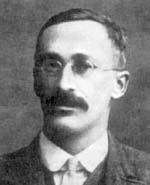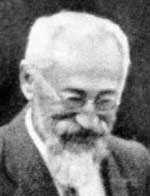Tales of Statisticians
William S Gosset
13 June 1876 - 16 Oct 1937Gosset earned a degree in chemistry at Oxford, and joined the Guinness brewery firm in 1899. His work for Guinness led him investigate the statistical validity of results obtained from small samples (previous statistical theory had concentrated instead on large samples). He took a leave of absence to spend 1906/1907 studying under Karl Pearson at University College, London. His publications in Pearson's journal Biometrika were signed "Student," not because of a Guinness company policy forbidding publication, as is often said, but more precisely because of a company wish to keep secret the fact that they were gaining an industrial advantage from employing statisticians. Gosset's most important result is known as the "Student's t" test or distribution, published in 1908. In these pages, we will drop the subterfuge and restore the discoverer's name to the discovery. We will call it "Gosset's t."
His work founded the concept of quality control, which Neyman and others were later to develop more fully. In studying the distribution of yeast cells, he independently discovered the Poisson Distribution, and demonstrated its utility in biological applications.

Gosset remained in contact with the Pearson group for the rest of his life. He was on the scene in the 1930's when Jerzy Neyman and Karl's son Egon Pearson were collaborating in London on their new theory of hypothesis testing, a collaboration which had begun in 1928 in Paris, when Pearson had interested Neyman in the problem of providing a proper mathematical basis for Gosset's t function. (That particular problem would be solved only later, by a student who learned of it in one of Neyman's lectures at Berkeley). Gosset was for long the only figure on friendly terms with both Pearson and Fisher, whose acrimonious and enduring hostility is one of the epic themes in statistics. W E Deming, of the U S Department of Agriculture, was at University College in this period, and described the scene in a letter written at the time:
"Karl Pearson and R A Fisher disagree almost to the point of taking up arms on some questions in statistics. K Pearson has no use for Student, either. Student and R A Fisher stand together. Fisher can say nothing good of Neyman and Pearson. I have heard from all sources that Egon Pearson is really a prince of a fellow."Florence Nightingale David had been working with Karl Pearson at the time, and later described the complex interrelationships to Constance Reid this way:
I saw the lot of them. Went flyfishing with Gosset. A nice man. Went to Fisher's seminars with Cochran and that gang. Endured K P. Spent three years with Neyman. Then I was on Egon Pearson's faculty for years.Fisher was very vague. Karl Pearson was vague. Egon Pearson vague. Neyman vague. Fisher and Neyman were fiery. Silly! Egon Pearson was on the outside.
They were all jealous of one another, afraid somebody would get ahead. Gosset didn't have a jealous bone in his body. He asked the question. Egon Pearson to a certain extent rephrased the question which Gosset had asked in statistical parlance. Neyman solved the problem mathematically.
The English intellectual scene is isolated in many ways, and highly contentious when not isolated. But somewhere in that mix of provinciality and acrimony, the right distance between contributors is sometimes achieved. The decade of the 1930's in the group around and against Karl Pearson seems to have been one of those productive moments. Some statistician should calculate the optimum distances and temperatures involved.

Deming, who had met Gosset at a meeting of the Royal Statistical Society, described him as "with a beard, very humble and of pleasing personality." Visually, however, he was a great disappointment to those who had wondered what he looked like: "Not very interesting after you find him."
Gosset died unexpectedly on 16 October 1937. Among the group, his loss was felt most keenly by Egon Pearson, who remarked perceptively:
"I think that there are so very many things that we owe to "Student" in the present statistical world. I would like to interest people in him, his practical mindedness and his simplicity of approach. It would be so easy for people to miss in the picture that large part he played simply by being in touch, by correspondence or personal meetings, with all the mathematical statisticians of his day."We might hazard the guess that the generously connective Gosset was, in part the catalyst, but perhaps more generally the communicating medium, of the great statistical surge of the English 1930's.
4 Sept 2004 / Contact The Project / Exit to Resources Page